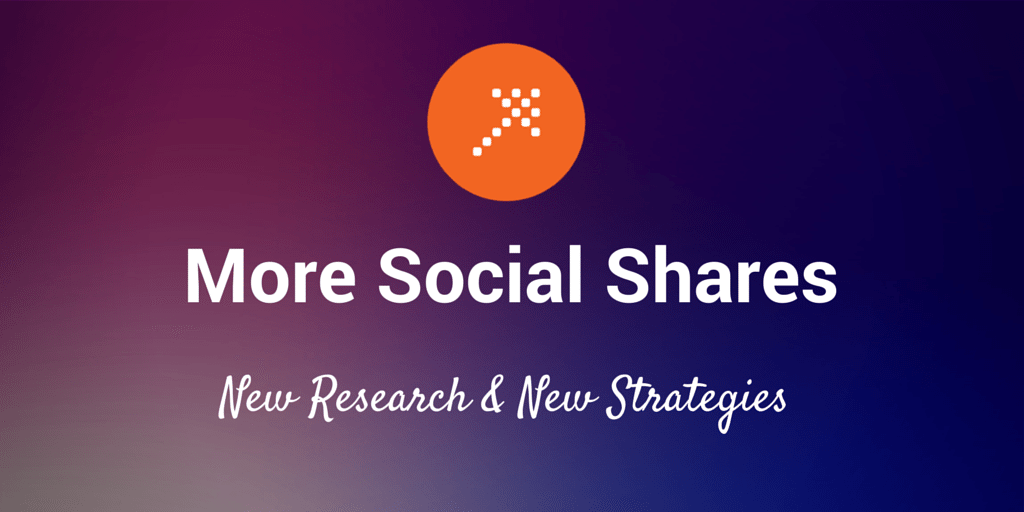
How to Build an Outreach Strategy to Earn More Social Shares
What are your digital marketing goals for the months ahead?
If you’re looking to increase your content’s social shares (as so many of us are), we’ve got some amazing new research to share on how to create an ideal outreach strategy for your industry.
BuzzStream and Fractl have collaborated to give you a jumpstart on optimizing your outreach for social traction. We analyzed 220 high- and low-engagement websites from 11 major verticals that produce content.
The result? A roadmap for planning for social success with your outreach strategy.

5 Research-Backed Ways to Earn More Social Shares
Earning the maximum amount of social engagement on your content requires that you carefully plot the factors that can put your campaigns and messages in front of the people who are most likely to help you share them.
We’ve found there to be five components to consider at the top of your list for outreach analysis:
- Publishers
- Keywords
- Platforms
- Social Influencers and Amplifiers
- Timing
That’s quite a bit of research to undertake before you send your first pitch email! We’d love to help make this research stage a bit easier for you.
Start Targeting for Social Traction
To show you what your outreach analyses for social traction might look like, we’ve put together a flipbook of insights from nine of the 11 verticals in our study. You’ll see top publishers, keywords, platforms, influencers, and publishing times that can launch your content to new social heights.
We’ve included the takeaways for the following nine industries in a free flipbook.
- Automotive
- Business
- Education
- Entertainment
- Finance
- Food
- Health
- News
- Travel
You can also download these infographics – along with our findings in the Lifestyle and Tech verticals – for free.
1. Find the platforms that share the most content from your vertical
If you’ve staked your entire social strategy on Facebook, you may be leaving a significant amount of share potential on the table.
It is true that Facebook is the uncontested king of content sharing for almost every vertical, earning 340% more shares weekly than each of the other four social networks. (The only exception in our study was the food vertical, in which 51% of content from high-engagement publications is shared on Pinterest.) But for some verticals and publishers, secondary platforms earn upwards of 30% of all social shares.

Just because they don’t share the most content doesn’t mean that secondary social networks aren’t important. You can’t ignore that Facebook is a sharing powerhouse, but once you’ve determined how to target your content for Facebook, consider:
- LinkedIn earned 21% of shares for high-engagement publications in the business vertical.
- Twitter earned 11% of shares for high-engagement tech publications, and 20–34% of shares for low-engagement business, finance, tech, and entertainment publications.
- Pinterest ranked second for a mix of high- and low-engagement publishers in health, lifestyle, food, and education.
Research the platforms that earn traction for the publishers you’re targeting in your vertical and take note of the type of content that earns shares on each. You may find that a few high-res photos or a trend analysis promoted on the right network can add a substantial amount of shares to your social earnings.
2. Learn your vertical’s sharing schedule
While a general search might tell you that the best day to publish on LinkedIn is Wednesday or the best day to promote on Facebook in Monday, the truth is that sharing peaks on different days in every vertical. If you have the flexibility to work with a publisher on the publication date, you can take advantage of trends among people who are regular followers of content in your vertical. For example:
- High- and low-engagement publications in the automotive vertical earn the most shares on Wednesday.
- Business publications see the most shares on Tuesday.
- Health peaks on Friday for high-engagement publishers, but Tuesday for low-engagement publishers.
- Food followers share the most on Mondays.

The weekends are a low point for sharing in every vertical, rarely earning more than 9% of shares for high- or low-engagement publishers. If possible, avoid publishing content on Saturdays or Sundays.
3. Determine which amplifiers are the most influential on target platforms
Similar to finding the publishers who routinely earn the most engagement in your vertical, finding the most effective sharers can give your content a boost. These social influencers are your second wave of promoters, giving your content a plug to their extended audiences after it goes live with publishers. Since social media can account for a substantial amount of traffic to your website, you may want to dedicate part of your promotion efforts to building relationships and outreach with key influencers for your vertical on the most relevant platforms.
A search of related hashtags, brands, and publishers is a good start to finding social amplifiers. When you have a handful of likely candidates who frequently promote content that matches your campaign, evaluate their appropriateness for your outreach efforts based on these five factors:
- Page Authority. Tools like Followerwonk and PeerIndex are good for evaluating the social authority of an influencer’s page.
- Domain Authority. Just like with publishers, you’ll want to take note of the Domain Authority of social influencers and understand the content on websites they represent.
- Number of followers. A person who tweets frequently about your topic but does not have a significant audience may not have the ability to significantly amplify your message.
- Retweet/share ratio. Compare how often the tweets of your target influencers are retweeted and shared. This will give you an idea of how much they may be able to extend the reach of your content.
- Reply ratio. Replies to a tweet are another marker of engagement. If your target influencer is considered an authority on your topic, replies and discussion may well follow their promotion of your content.
4. Research the keywords your audience is looking for
Once you’ve decided which publishers are the best fit to meet your goals, the next step is to identify the keywords that will resonate most with their audiences. While it may seem obvious that keywords that work in the food vertical won’t attract attention in the tech vertical, effective keywords are even more varied than that. There are often wide differences in the keywords that gain traction between high- and low-engagement publishers within the same vertical, and among keywords from the same groups of publishers on different social platforms.
For example, in the tech vertical, the word “giveaway” was the fourth most-shared term from low-engagement publishers on average in our study, but these shares occurred on Facebook, Twitter, and Google+, and not on LinkedIn or Pinterest. If your tech campaign is geared towards executives or women, it will be particularly important to look closer than the broad keyword trends in this vertical to find the terms likely to be most effective.
Researching the keywords that perform well for specific publishers and verticals will always yield insights into how you can improve your verbiage. Two trends may also give you advantage:
- Headlines with positive adjectives and knowledge-based verbs tend to do better across the board. While most writers and editors write their own headlines for the articles they publish, you can offer subtle suggestions in your subject line or call attention to intriguing facts in your pitch that might make good headline fodder.
- Photos and data visualizations earn shares in almost every vertical. Words related to images make popular content for both high- and low-engagement publishers.
5. Target the publishers who earn the most traction for their content
First, consider the publishers who are potential targets for outreach. Depending on your content goals, you might consider high-engagement publishers (sites that typically earn more than 20K average shares), low-engagement publishers (those that typically earn fewer than 20K shares), or a mix of both.
If you’re not sure why you might target low-engagement sites when your goal is to earn the most social shares possible, consider the challenges and benefits of each type of publisher.
High-engagement publishers
- Pro: A large social audience means increased potential for shares.
- Con: These sites usually receive hundreds of pitches a day because of their high profile. This competition can make it challenging to earn placements for stories that are not particularly new or novel.
Low-engagement publishers
- Pro: These sites can have narrow but highly-targeted audiences, which may earn you more prominent exposure to specific segments of your audience.
- Con: Their smaller social audience means lower sharing numbers overall.
Large, high-traffic sites are great for piquing interest in a new angle or market. Content designed to excite and intrigue in the awareness stage of the buying cycle may earn the most interest with high-engagement publishers. Conversely, niche or local sites can offer more focus on audiences who are researching potential purchases. Content designed to supply more information or persuade customers to buy in the consideration stage of the buying cycle might earn fewer social shares but more conversions with low-engagement publishers. Both categories of publisher can offer advantages depending on the goals of your marketing strategy.
Five factors will help you determine whether a publisher or author is the best fit for your social traction goals:
- Prior coverage of related topics. Take a look at past articles to determine the story angles and depth to which they examine the topic of your campaign.
- Number of shares their content has recently earned on each network. A quick inventory of their presence on each social media network will tell you where their audience is most concentrated.
- Number of shares they’ve recently earned for keywords in your vertical. If they earn lots of shares most of the time, but never for the keywords you’re targeting, they may not be the best outlet for your content.
- Total average shares per piece of content. Calculating the average shares their content receives will help you set realistic benchmarks for your social goals and help you understand the pool of potential customers you’re working to convert.
- Domain Authority. A site’s Domain Authority is a signal of how well the site will perform in a search. Targeting sites with high DA scores will benefit your SEO efforts.
Conclusion
We hope this research into outreach strategies helps solidify your strategies for getting more social shares on your content. Keep in mind the five components of an outreach strategy:
- Publishers
- Keywords
- Platforms
- Social Influencers and Amplifiers
- Timing
And grab some key insights for your specific industry to help you get ahead with your outreach plans.
I’d love to hear how this research fits with your experience. What outreach strategies do you have in place? What components do you consider? It’d be great to hear from you in the comments!
Image sources: Blurgrounds, IconFinder, Unsplash
Try Buffer for free
140,000+ small businesses like yours use Buffer to build their brand on social media every month
Get started nowRelated Articles

If you always feel like you’re chasing the tail-end of audio trends on the app, you’ve come to the right place. In this article, I’ll guide you through all the methods you can use to find the most popular music and sounds on Instagram before they drop off the charts.

All the features on Bluesky, plus how to use them.

I put Meta Verified — and the coveted blue check — under the microscope for two weeks. The results were definitely not what I expected.